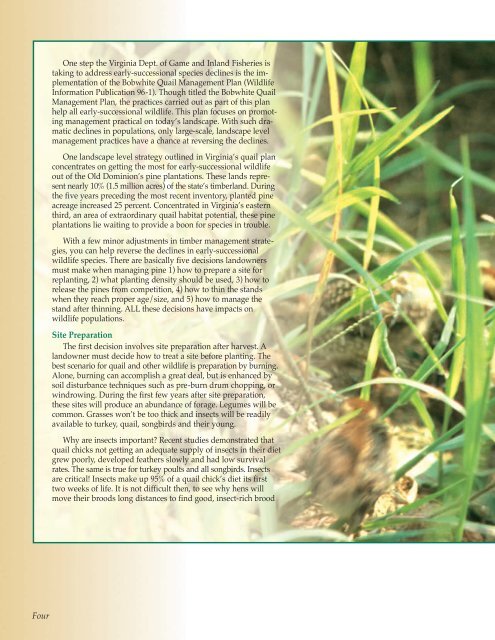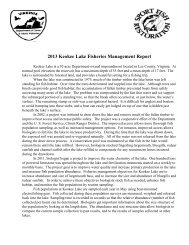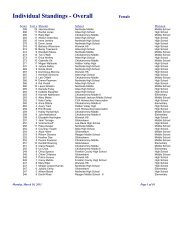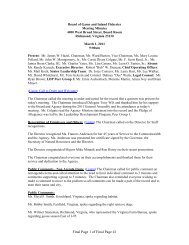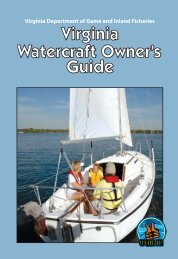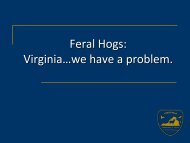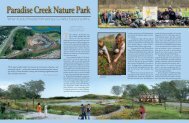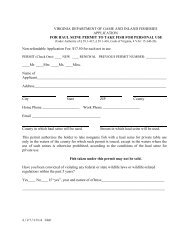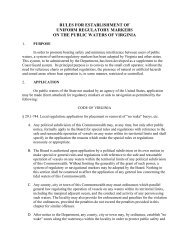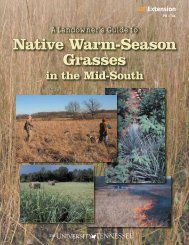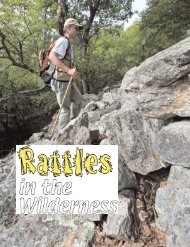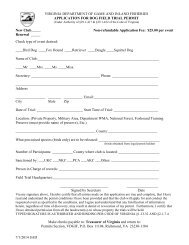Managing Pines for Profit and Wildlife - Virginia Department of ...
Managing Pines for Profit and Wildlife - Virginia Department of ...
Managing Pines for Profit and Wildlife - Virginia Department of ...
Create successful ePaper yourself
Turn your PDF publications into a flip-book with our unique Google optimized e-Paper software.
One step the <strong>Virginia</strong> Dept. <strong>of</strong> Game <strong>and</strong> Inl<strong>and</strong> Fisheries istaking to address early-successional species declines is the implementation<strong>of</strong> the Bobwhite Quail Management Plan (<strong>Wildlife</strong>In<strong>for</strong>mation Publication 96-1). Though titled the Bobwhite QuailManagement Plan, the practices carried out as part <strong>of</strong> this planhelp all early-successional wildlife. This plan focuses on promotingmanagement practical on today’s l<strong>and</strong>scape. With such dramaticdeclines in populations, only large-scale, l<strong>and</strong>scape levelmanagement practices have a chance at reversing the declines.One l<strong>and</strong>scape level strategy outlined in <strong>Virginia</strong>’s quail planconcentrates on getting the most <strong>for</strong> early-successional wildlifeout <strong>of</strong> the Old Dominion’s pine plantations. These l<strong>and</strong>s representnearly 10% (1.5 million acres) <strong>of</strong> the state’s timberl<strong>and</strong>. Duringthe five years preceding the most recent inventory, planted pineacreage increased 25 percent. Concentrated in <strong>Virginia</strong>’s easternthird, an area <strong>of</strong> extraordinary quail habitat potential, these pineplantations lie waiting to provide a boon <strong>for</strong> species in trouble.With a few minor adjustments in timber management strategies,you can help reverse the declines in early-successionalwildlife species. There are basically five decisions l<strong>and</strong>ownersmust make when managing pine 1) how to prepare a site <strong>for</strong>replanting, 2) what planting density should be used, 3) how torelease the pines from competition, 4) how to thin the st<strong>and</strong>swhen they reach proper age/size, <strong>and</strong> 5) how to manage thest<strong>and</strong> after thinning. ALL these decisions have impacts onwildlife populations.Site PreparationThe first decision involves site preparation after harvest. Al<strong>and</strong>owner must decide how to treat a site be<strong>for</strong>e planting. Thebest scenario <strong>for</strong> quail <strong>and</strong> other wildlife is preparation by burning.Alone, burning can accomplish a great deal, but is enhanced bysoil disturbance techniques such as pre-burn drum chopping, orwindrowing. During the first few years after site preparation,these sites will produce an abundance <strong>of</strong> <strong>for</strong>age. Legumes will becommon. Grasses won’t be too thick <strong>and</strong> insects will be readilyavailable to turkey, quail, songbirds <strong>and</strong> their young.Why are insects important? Recent studies demonstrated thatquail chicks not getting an adequate supply <strong>of</strong> insects in their dietgrew poorly, developed feathers slowly <strong>and</strong> had low survivalrates. The same is true <strong>for</strong> turkey poults <strong>and</strong> all songbirds. Insectsare critical! Insects make up 95% <strong>of</strong> a quail chick’s diet its firsttwo weeks <strong>of</strong> life. It is not difficult then, to see why hens willmove their broods long distances to find good, insect-rich broodFour


